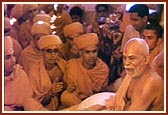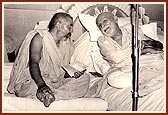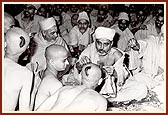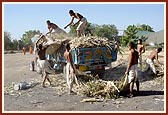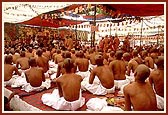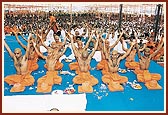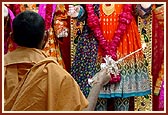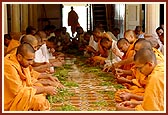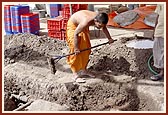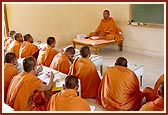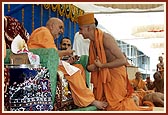
|
 |
|
|
|
The
Sadhu Tradition In Swaminarayan Sampraday
|
|
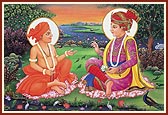 Bhagwan Swaminarayan and Aksharbrahma Gunatitanand Swami |
On 27-11-1968, Brahmaswarup Yogiji Maharaj forecasted, "Pramukh Swami will initiate 700 sadhus." This divine wish of Yogiji Maharaj was fulfilled on the occasion of the 111th birthday celebration of Yogiji Maharaj (Yogi Jayanti), celebrated in his beloved Akshar Mandir in Gondal, by Pramukh Swami Maharaj. On this historic occasion, a brief account of the sadhu tradition in the Swaminarayan Sampraday is presented here. |
|
Mandirs, scriptures and sadhus are recognized as the pillars of Hindu culture and tradition. Bhagwan Swaminarayan preserved and promoted all three. Just like the special impact made by the mandirs He had built, and the scriptures He inspired, the tradition of pure sadhus He initiated has created a unique impression throughout the world. Describing the life of sadhus in the
Swaminarayan Sampraday, Sadguru Nishkulanand Swami, one of Bhagwan
Swaminarayan's eminent saint-poets, writes: "Gurjardeshma sant
farta, karta Harini varta;
Panchvrate pura shura, Harine sambharta." "Sadhus toured in the regions of Gujarat,
preaching the message of God; Bhagwan Swaminarayan had instructed the sadhus to strictly observe the five vartmans (vows): 1. Nishkami Vartman: 2. Nirlobhi Vartman: 3. Niswadi Vartman: 4. Nisnehi Vartman: 5. Nirmani Vartman: In addition to these five vartmans, Bhagwan Swaminarayan said, "The highest dharma of a renunciant is to offer devotion to God coupled with a total understanding of His glory." (Satsangijivan) |
|
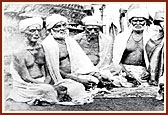 Rare photographic image of four paramhansas of Bhagwan Swaminarayan, (L to R) Pujya Pragnanand Swami, Pujya Bhumanand Swami, Pujya Adbhutanand Swami, Pujya Pavitranand Swami 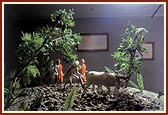 Pramhansas travelled to villages to inspire character and faith in farmers ... 
... blacksmith, and downtrodden people |
In short, He created a cadre of sadhus who strictly practiced the five vartmans and offered parabhakti - the highest devotion. The history of the Sampraday reveals that He initiated over 3000 sadhus. However, some of them were killed by evil-minded bawas, who felt threatened by the purity of these sadhus. To protect His sadhus from this inhuman onslaught, Bhagwan Swaminarayan initiated 500 paramhansas. The list of their names is recorded in 'Haricharitramrut Sagar'. The senior among them included: Aksharbrahma Sadguru Gunatitanand Swami, Yogamurti Sadguru Gopalanand Swami, Sadguru Muktanand Swami, Sadguru Nityanand Swami, Sadguru Brahmanand Swami, Sadguru Premanand Swami and Sadguru Nishkulanand Swami. The paramhansas travelled from hut-to-hut and village-to-village inspiring morality in the lives of people and peace and security in society. "Sahajanand Swami revived the lost practice of brahmacharya, purified the unruly and independent image of sadhus, set an ideal of self-control to gurus and acharyas who had strayed from their path." This observation by the renowned Gandhian Kishorelal Mashruwala is a fitting recognition of Shriji Maharaj's contribution in reviving the pure traditions of sadhus. Subsequently, His ideals have been upheld and promoted by the succession of Gunatit Sadhus He introduced. |
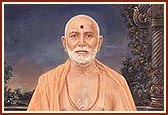 Brahmaswarup Shastriji Maharaj |
In 1906, Brahmaswarup Shastriji Maharaj left Vartal with five sadhus and founded the Bochasanwasi Shri Akshar Purushottam Swaminarayan Sanstha (BAPS) to preach the true philosophy of Akshar and Purushottam as propagated by Bhagwan Swaminarayan in the Vachanamrut. Over the next few decades, inspired by Shastriji Maharaj's saintly life, many accepted initiation from him into the sadhu-fold. When Brahmaswarup Shastriji Maharaj returned to Akshardham in 1951, there were about 50 sadhus. In those early days, these sadhus tolerated many hardships to give the BAPS a solid foundation, from which, today, the worship of Akshar and Purushottam has spread to over 50 countries. |
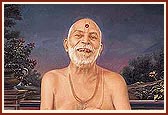 Brahmaswarup Yogiji Maharaj
|
After Shastriji Maharaj, Brahmaswarup Yogiji Maharaj became the guru and he revolutionized the concept of initiating sadhus. He initiated many highly educated youths into the sadhu-fold. Yogiji Maharaj initiated about 100 youths into the sadhu order. However, the occasion of the Gadhada Kalash Mahotsav in 1961 when he initiated 51 educated youths was a milestone in the history of the Swaminarayan Sampraday. Since, for many years, Yogiji Maharaj had expressed his wish, "I want to initiate 51 sadhus on the occasion of the Gadhada Kalash Mahotsav." This historic occasion in Gadhada revealed the selfless love and profound saintliness of Yogiji Maharaj. Today, many are surprised to see the large number of highly educated sadhus serving in the BAPS. The credit for this goes to Yogiji Maharaj. Before returning to Akshardham, Yogiji Maharaj revealed, "Pramukh Swami is my all," and declared Pramukh Swami Maharaj as his successor. Yogiji Maharaj also prophesied, "Pramukh Swami will initiate 700 sadhus." |
|
|
Since then, this divine wish of Yogiji Maharaj and the saintly life of Pramukh Swami Maharaj has drawn hundreds of youths of all backgrounds, from many countries to accept initiation into the sadhu-fold. In 1973, on the occasion of the Kalash Mahotsav of Amdavad Mandir, Pramukh Swami Maharaj initiated 53 sadhus. Then in 1981, on the occasion of Bhagwan Swaminarayan's Bicentenary Celebrations, Pramukh Swami Maharaj initiated 194 youths (159 parshads & 35 sadhus). In 1985, on the occasion of Aksharbrahma Gunatitanand Swami's Bicentenary Celebration, he initiated 174 youths (58 parshads & 116 sadhus); in 1992, during Yogiji Maharaj's Centenary Celebrations, he initiated 130 youths (81 parshads & 49 sadhus); in 1995, during the Amrut Mahotsav, he initiated 82 youths (32 parshads & 50 sadhus). In this way, over the years on many festival occasions, Pramukh Swami Maharaj has initiated hundreds of youths into the sadhu order. |
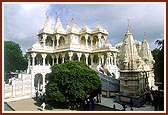 Swaminarayan Mandir, Sarangpur |
To guide and train the sadhus on the spiritual path, Pramukh Swami Maharaj founded a Training Center for sadhus at Sarangpur in Saurashtra in 1981. |
|
|
Satsangi youths who wish to become sadhus, initially spend 12 to 18 months as sadhaks (novices) in the training center. For this, youths aged 21 or over are given entry every December and March. During this initial period, they wear a jhabho and dhotiyu. Throughout the year, they engage in various services (seva), study the Swamini Vato (discourses of Aksharbrahma Gunatitanand Swami), memorize kirtans and study other topics also. They are given guidance regarding service and austerities. During this time, sadhaks observe the vows of a sadhu, except that in certain circumstances they can meet and visit their family members. During this intense training a sadhak has the opportunity to strengthen his wish to become a sadhu. At the end of this initial training, and with the written consent of his parents, Pramukh Swami Maharaj initiates him into the parshad order. |
|
|
On receiving this initiation, the parshad wears white robes and stitched clothing is renounced. His head is clean shaven, except for a small shika (tuft of hair) and he is given a janoi. With this, the five vartmans given by Shriji Maharaj are strictly observed. Even in this parshad stage, training continues. During this period the Vachanamrut (Discourses of Bhagwan Swaminarayan) and the lives of the Gunatit Gurus are studied in detail. Besides this, service and austerities also continue. After about 12-18 months, Pramukh Swami Maharaj gives the bhagvati diksha to the parshads. They now wear saffron robes and are given a new name. After initiations into the sadhu-fold, the Upanishads, Mahabharat, Shrimad Bhagwat, Bhagvad Gita, other Hindu scriptures and world religions are studied. English, Hindi, Sanskrit and other languages are also studied. In addition, music, art and other creative subjects are studied by those who have an aptitude and talent. Together with these studies, regular service and austerities continue. The daily routine of sadhus living in the training center commences at 4.00 a.m. While remembering God, they bathe and perform personal puja. Then they attend the mangala arti at 5.45 a.m. From 6.00, various services begin: cleaning the mandir compound, making flower garlands for the deities, cutting vegetables, preparing meals, performing mahapuja, adorning the deities, cleaning the ashram, etc. In the afternoon and evening, sadhus, in turn, wash the utensils. Every 15 days, the allocated service changes, so that they gain experience and expertise in all types of service. At 7.15 a.m. all attend the shangar arti. After the arti, two bhajans are sung describing and praising the murti of God. Then all go for darshan of the Yagnapurush Smruti Mandir (mandir built over the cremation site of Brahmaswarup Shastriji Maharaj.) Then after breakfast, at 8.00 a.m., the morning discourse takes place. For one hour, experienced senior sadhus who teach in the training center deliver discourses based on the Vachanamrut, giving guidance and inspirations regarding the life of a sadhu. Between 9.00 a.m. and 12.00 p.m., study classes, based on the syllabus described above, are held in the 'Yagnapurush Sanskrit Vidyalay' in the mandir premises. At 12.00 noon, lunch is served. The menu is common for all, except for those who are ill. Sadhus eat in a small wooden bowl. While the food is being served, everyone chants the Swaminarayan mahamantra aloud. Then Vedic prayers are recited in unison before the eating ritual begins. At 12.30 p.m. in the assembly hall, afternoon discourses are held upto 1.00 a.m. Then in the afternoon, sadhus engage in personal study. At 4.00 p.m. all gather in the assembly hall for meditation as the deities are awakened from their afternoon rest. Scriptures are also read. From 4.30 to 6.30, study classes take place. At 7.30 p.m., the sandhya arti is performed. Thereafter, all bow to each other, touching everyone's feet, and bid "Jai Swaminarayan." At 8.00 p.m. dinner is served. At 8.45 p.m., the evening assembly commences. For 30 minutes, devotional songs are sung by sadhaks, parshads or sadhus. Then the report of Pramukh Swami Maharaj's vicharan is read. Sometimes, other special programs are organised. At 9.45 p.m., the cheshta, describing the divine murti and daily routine of Bhagwan Swaminarayan, is sung. At 10.15 p.m. all bid 'Jai Swaminarayan' to each other before leaving the assembly hall. Then, after spending an hour in personal study, at 11.30 p.m. they retire to sleep. Sadhus use a thin mattress for bedding. They sleep in the common dormitories or on the terrace, depending on the weather. Nobody has a separate room. In all these activities, the harmony between the sadhus is strengthened. Despite hailing from different regions, countries and educational backgrounds, they blend with one another in a unique spirit of unity. Thus, they are actively absorbed between 16-18 hours a day in their spiritual endeavors to please God. The sadhus regularly observe between 5
and 7 waterless fasts every month. Many eat only once a day. They also
undertake other difficult austerities, such as, dharna-parna,
chandrayan, khatras, tuptakruchh, etc. After spending 5 years in the training
centre, Pramukh Swami Maharaj appoints the sadhus to the various BAPS
mandirs to engage in a variety of services. At over 500 mandirs, sadhus
actively manage over 160 humanitarian services, including social, educational,
moral, cultural and spiritual activities. Pramukh Swami Maharaj has initiated 24
educated youths from USA and Canada, 44 from England and 10 from Kenya,
6 from Uganda, 3 from Tanzania, 1 from South Africa and 2 from Nepal
into the sadhu order. It is indeed a miracle Pramukh Swami Maharaj has
inspired such youths, raised in a Western environment, to willingly
accept the strict vows and disciplines of a sadhu. |
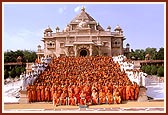 BAPS sadhus with Swamishri in Akshardham, Gandhinagar |
This cadre of learned and dedicated sadhus, who seek to attain spiritual liberation and serve society, are a priceless gift to the world given by Bhagwan Swaminarayan and the Gunatit gurus. Since, the wisdom of these sadhus bring inner peace, their activities solve society's problems and their lives exemplify the true ideals of India's noble sadhu tradition. |
|
Chãndrãyan: |
|
| | Yogi Jayanti | Yogi Smruti Mandir | Diksha Ceremony | Evening Assembly | Sadhu Tradition | |
|
|
|
© 2003, Bochasanwasi
Shri Akshar Purushottam Swaminarayan Sanstha, Swaminarayan Aksharpith
|

